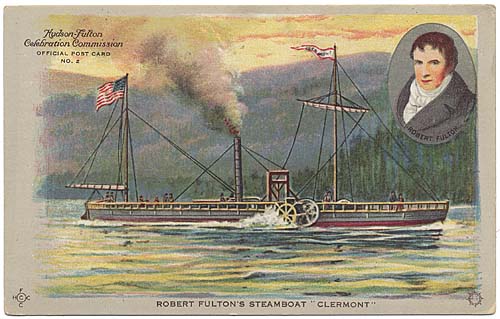On this day in 1807, the North River Steamboat (later named Clermont) launches on the Hudson River in New York City and heads for Albany, New York, inaugurating the first commercial steamboat service in the world. Robert Fulton, who seven years earlier had engineered the very first submarine - the Nautilus, designed the North River. The trip from New York City to Albany, done at what was then break neck speed, would take 32 hours.


The Historical Inebriant: The Steamboat Cocktail
Ingredients:
I came across this in my internet travels and could not resist posting. I don't own a kindle, but apparently if I did I would be able to borrow this book for free. It's worth taking a look at the preview on Amazon for some very odd cocktails.

http://www.amazon.com/SteamDrunks-Steampunk-Cocktails-Drinks-ebook/dp/B006ZT0EZQ
__________________________________________________________________
Per Wiki:
In 1970 Philips Co. based in the Netherlands began developing an audio disc system using laser technology designed to replace vinyl records. It would later partner with Sony in the developmental stage and the story goes that the prototype disc that Philips presented to Sony was 11.5cm in diameter. Sony insisted that the new disc format must be able to hold the entirety of Beethoven's 9th Symphony. The CD size was later increased to 12cm to accommodate the extra data.

Ingredients:
1 part Vodka
1 part Coffee Liqueur
1 Ice cube
1 part Whipping Cream
Pour all ingredients into shaker and mix. Strain into a cocktail glass._____________________________________________________________________
I came across this in my internet travels and could not resist posting. I don't own a kindle, but apparently if I did I would be able to borrow this book for free. It's worth taking a look at the preview on Amazon for some very odd cocktails.

http://www.amazon.com/SteamDrunks-Steampunk-Cocktails-Drinks-ebook/dp/B006ZT0EZQ
__________________________________________________________________
Per Wiki:
1982 – The first Compact Discs (CDs) are released to the public in Germany.
When I first read this entry, I wondered if it meant the first CDs in the world were released on this day or was it just in Germany? As I started to look for the answer, it dawned on me that it really didn't matter since in a year, or five, or ten, the CD will go the way of the cassette tape, the vinyl record, the 8-track, and the record single. More importantly I remember when albums had themes all their own, think Jethro Tull's "Aqualung" or The Who's "Tommy" and I fear that may be lost in the coming years.
A friend of mine writes a great blog about music and has put his memories of music formats (and how the medium used to be part of the message) into a wonderful post. I have excerpted a passage here, but please take the time to read it in full:
http://www.alternativecontrolct.com/music/instant-gratification-vs-eventual-appreciation-a-commentary-on-modern-music-culture/#more-2221
By the way -
The album or CD as a tangible thing is dying. A generation of kids are growing up into a world where all their media is given to them by just a few clicks and into a tiny computer. Sleeve designs and beautiful album art like the cover to any Yes, Iron Maiden or Pink Floyd record are reduced to tiny icons. Lyric sheets and linear notes are produced digitally, if at all. And I’m really wondering if I’m the only one that’s saddened by this. I feel that an album in itself is a complete work of art. It should be listened to and appreciated from start to finish. The artwork, the lyrics, the band photos and the linear notes are all part of that package, and part of the enjoyment. Buying something tangible, looking through the sleeve or the booklet as the music plays, following along with the lyrics – that’s what enjoying music is all about for me. It’s like taking a little journey. If you take that ritual away, what’s stopping the album concept from disappearing entirely?Christopher Baldwin
http://www.alternativecontrolct.com/music/instant-gratification-vs-eventual-appreciation-a-commentary-on-modern-music-culture/#more-2221
_____________________________________________
By the way -
In 1970 Philips Co. based in the Netherlands began developing an audio disc system using laser technology designed to replace vinyl records. It would later partner with Sony in the developmental stage and the story goes that the prototype disc that Philips presented to Sony was 11.5cm in diameter. Sony insisted that the new disc format must be able to hold the entirety of Beethoven's 9th Symphony. The CD size was later increased to 12cm to accommodate the extra data.
The next time you listen to a CD, thank Phillips and Sony and more importantly - Ludwig van.
For a brief history of the CD:



